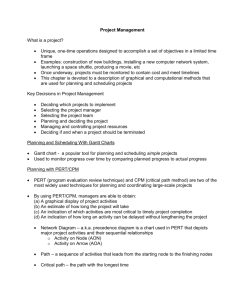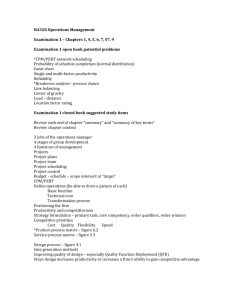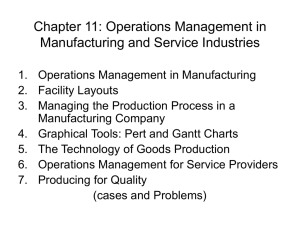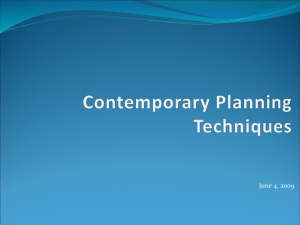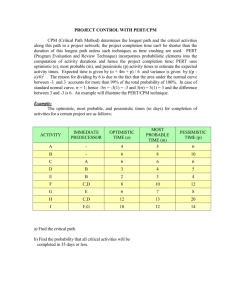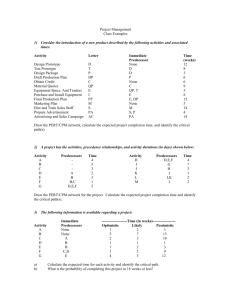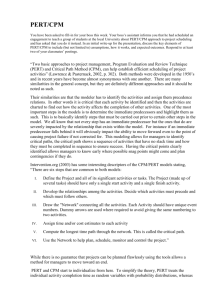Chapter 16 Program Management and Project Management Project
advertisement
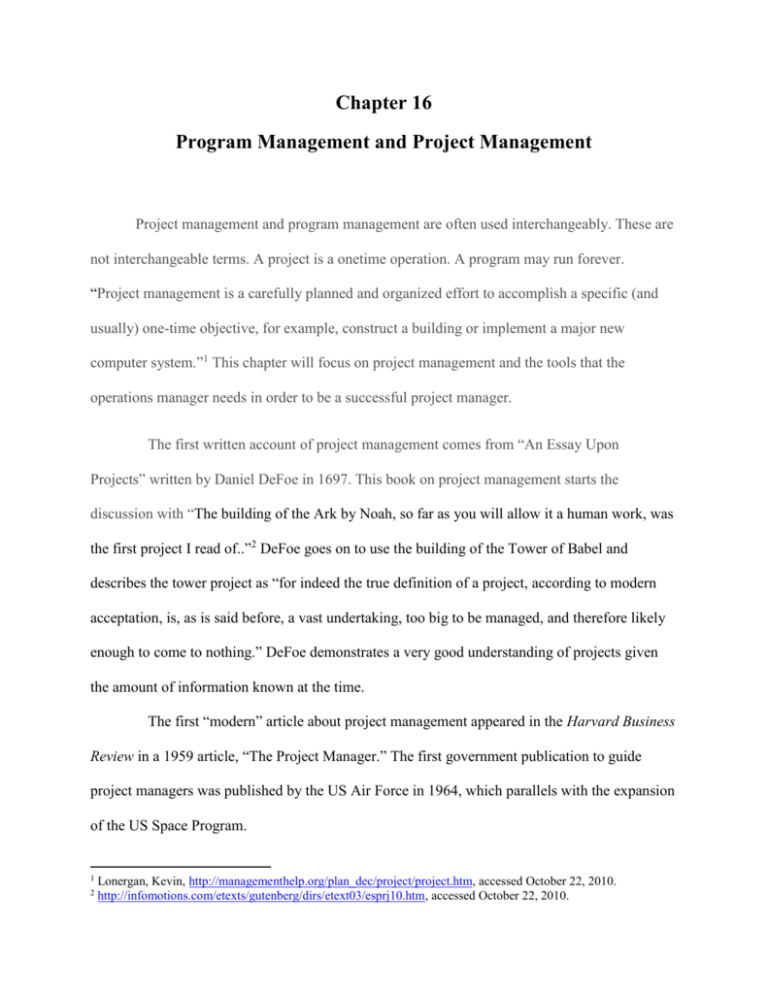
Chapter 16 Program Management and Project Management Project management and program management are often used interchangeably. These are not interchangeable terms. A project is a onetime operation. A program may run forever. “Project management is a carefully planned and organized effort to accomplish a specific (and usually) one-time objective, for example, construct a building or implement a major new computer system.”1 This chapter will focus on project management and the tools that the operations manager needs in order to be a successful project manager. The first written account of project management comes from “An Essay Upon Projects” written by Daniel DeFoe in 1697. This book on project management starts the discussion with “The building of the Ark by Noah, so far as you will allow it a human work, was the first project I read of..”2 DeFoe goes on to use the building of the Tower of Babel and describes the tower project as “for indeed the true definition of a project, according to modern acceptation, is, as is said before, a vast undertaking, too big to be managed, and therefore likely enough to come to nothing.” DeFoe demonstrates a very good understanding of projects given the amount of information known at the time. The first “modern” article about project management appeared in the Harvard Business Review in a 1959 article, “The Project Manager.” The first government publication to guide project managers was published by the US Air Force in 1964, which parallels with the expansion of the US Space Program. 1 2 Lonergan, Kevin, http://managementhelp.org/plan_dec/project/project.htm, accessed October 22, 2010. http://infomotions.com/etexts/gutenberg/dirs/etext03/esprj10.htm, accessed October 22, 2010. Project Management is an industry unto itself, has its own published Body of Knowledge, and its own certifying body. Project Management is defined by the Project Management Institute as: “Project management is the application of knowledge, skills, tools, and techniques to a broad range of activities in order to meet the requirements of a particular project.”3 Wikipedia defines a project as “a temporary and one-time endeavor undertaken to create a unique product or service, that brings about beneficial change or added value.”4 A project is a onetime operation with a defined beginning and a defined end. This chapter is designed to give the potential project manager the knowledge, skills and some of the tools necessary to successfully lead a project. Thus far we have emphasized that projects are a onetime operation. Programs on the other hand are not onetime operations. Programs may go on forever and some government programs seem to go on forever even after the program has outlived its intentional purpose. A program could conceivably have thousands of projects under the program. Project Planning A project must have a plan in order to be successful. A survey of professional engineers showed that the lack of a project plan was the second most common reason for project failures. The only factor more prevalent than a lack of planning was simply not following basic management principles by focusing on the systems vice the plan and the goals of the project. A good plan will help prevent having a constraint in the areas of personnel and resources after the project is started. 3 Source: Project Management Institute - http://www.pmi.org/info/PP_AboutProfessionOverview.asp?nav=0501, accessed on June 2, 2009. 4 http://en.wikipedia.org/wiki/Project_management, The first document that drives the project planning is the statement of work. This document describes the goals of the project, the timeframe for completing the project, and the work to be performed. A poorly written statement of work will lead to project frustration and maybe even the inability to complete the project on time and within budget. A good statement of work will help the project leader to identify the manpower requirements, help establish a valid budget, and show the relationship between the activities in the project. In addition, the statement of work should specify the completion date of the project. Without this completion date, one of the critical aspects of a project is missing. The statement of work enables the project leader to analyze exactly what is being asked for and determine the real resources requirements and develop a valid timeline for completion of the project. Once the statement of work is analyzed, the project leader can develop the objectives for his/her project team. The project leader can establish the precedent of events and the associated time frames for each event and from that listing of events, the project leader can forecast the completion time frame for the project. From a good statement of work the project leader will be able to do a detailed mission analysis of the project and identify all tasks – those that are specified in the statement of work and those tasks that may not be specified but are implied. An implied task is one that the project leader knows from experience must be accomplished in order to accomplish the specified tasks. For example if the specified task is to pour the foundation for a building, there are some implied tasks such as grading the land, putting the forms in place and roughing in the plumbing before the foundation can be poured. Determining the implied and specified tasks enables the project leader to determine what the US Military calls a “troop to task analysis.” This analysis is necessary for the project leader to select the proper skills and personnel for the team as well as determining the right number of members to have on the team. Too many team members may lead to project failures and too few project team members may lead to project delays and not meeting the project deadlines. By carefully analyzing the statement of work, the project leader can develop a work breakdown structure that details exactly what each team member will do and may be able to break the project into modules to assist in scheduling and completing the project on time. Determining the right mix of personnel is also important to ensure the team is functional. One of the problems with project teams is that they are not permanent members of the team. The team members belong to another operation, department, or program. This creates a matrix management organization and a challenge for project leaders. The challenge here is that the team members know that their annual performance appraisals will be written by someone other than the project leader. Therefore, their allegiance is to their real boss since that boss determines the success or failure of their careers. This is not an insurmountable challenge, just one more consideration when choosing teams and team members. Project Control Project control involves all the activities to ensure the successful completion of the project. The success of the project is based on the detailed analysis and identification of all important tasks. Once the tasks are identified, it is important to make sure the order of precedence is established to make sure supporting activities are completed before the next activity starts. Back to our example of pouring the foundation – all of the implied tasks must be completed before the task of pouring the foundation can be started. The next step is developing the budget for the project. The statement of work should provide a maximum amount the company is willing to spend on the project, but that does not mean that the entire amount needs to be spent on the project. The analysis by the project leader will enable the development of the budget. Once the budget is established, project controls are necessary to ensure that the project is completed within or even under budget. One of the greatest sins of project management is busting the budget for the project. The only worse sin of project management is not completing the project within the specified time frame. Gantt Charts One of the common methods of providing project control is the Gantt chart. Developed by Henry Gantt early in the last century, these charts have been in use for projects for almost one hundred years. The Gantt chart is a simplistic approach to project management. The chart is a bar chart that is easy to understand. Using the bar chart, a company can quickly identify if they are on schedule or behind schedule. The television show, “Extreme Makeover – Home Edition,” uses Gantt charts to track their progress in building a new home for the featured family. On this show the goal is to demolish and rebuild a dream home within a week. Project control is critical for the completion of the house. The Gantt chart allows the project leader to quickly check the day and hour and see if the team is on track. Before the days of computers and automation, the Gantt chart was critical in the control of projects such as the Interstate Highway System and the building of the Hoover Dam. The chart shows the time frames and the amount of work that should be completed in that time frame. Although almost one hundred years old, it is still a popular tool for project control because of its simplicity and ease of reading. In order to develop a Gantt chart, the project leader needs to know the tasks, the time to complete each task, and the order of precedence for the tasks. Figure 16-1 shows an example of a Gantt chart. Figure 16-1: A Gantt Chart Developed Using Excel PERT/CPM Charts There are two other commonly used techniques for tracking and controlling projects. The Critical Path Method (CPM) and the Program Evaluation and Review Technique (PERT) are very similar. Both provide a network diagram of all the actions necessary to complete a project. The CPM and PERT diagrams are a little more complex than the Gantt chart. The Critical Path Method was developed in 1956 by Remington-Rand. The CPM provides tradeoffs between project duration reduction and the increases in project costs and activities. CPM uses deterministic times and shows the times on the nodes of the network. Figure 16-2 shows the CPM diagram that corresponds with the Gantt chart in Figure 16-1. The CPM shows a “Dummy” activity – the “Dummy” is an activity with activity that does not impact the critical path but must be completed before the next activity can be started. The CPM diagram also tells if there is any slack in the network. Slack is where moving the activity forward or backward will not impact the completion time. There is no slack on the critical path. In the diagram below the critical path is A-C-D-F. Any slack that will allow for an earlier or later start time will not be on the critical path. So, in this example, there is no slack for A, C, D, or F. The CPM network calculations are shown in Figure 16-3. For the diagram in Figure 16-2, the completion time is 14 periods. The project cannot be completed in a shorter time without changing the inputs and resources for the project. The critical path is the longest pass through the network. Figure 16-2: Critical Path Method Diagram Figure 16-3: Using The Management Scientist Software to Calculate Slack, Earliest Start Times and Latest Start Times for the CPM The Project Evaluation and Review Technique was developed in conjunction with the S Navy for the building of the Polaris Submarines in the 1950s. PERT provides three time forecasts to account for uncertainty in completion times. This is the biggest difference between the CPM and PERT diagrams. The PERT has an optimistic time, a pessimistic time and a most likely time. In addition, the PERT diagram has the time estimates on the arrow vice the node as in the CPM diagram. Either diagram will enable the project leader to control the operations. Figure 16-4 shows a PERT diagram with the time estimates. Since there is a range of time estimates for the PERT network, the equation in Formula 16-1 is used to calculate the estimated completion time for the entire network. Figure 16-4: PERT Chart Formula 16-1: Calculation of Estimated Time for the PERT network For example, using the times to complete A-B, the estimated completion time for that activity shown in Figure 16-4 will be (3 + (4x5) + 9)/6. Therefore the estimated completion time for activity A-B will be 5.33 periods. Project Crashing Can the project be finished sooner than planned? The project is running behind schedule, can we finish on time? The answers to these questions come from the concept known as project crashing. Project crashing is a methodology to reduce the project completion time by expending additional resources. The crash time is the amount of time that an activity can be reduced. However, there is usually a cost of crashing a project since more resources are added to the project. The closer a project is to the planned completion time, the greater the cost to crash a project. The goal of project crashing is to complete the project earlier or on time at a minimum cost. Reducing a project’s length is acceptable as long as the cost of crashing the project do not exceed the indirect costs. In some projects, there is a penalty assigned to not completing on time. In this case, there is a trade off analysis necessary to determine if the penalties for not completing on time exceed the costs of crashing the project. Life Cycle Management Life Cycle Management is part of the project management umbrella. Life Cycle Management looks at the long term costs of the project and not just the short term costs. In some organizations this is known as the care and feeding of the project. Life Cycle Management would look at the life of a product if the project charter was to develop a new product for the company. The project is focused on the product development however; a successful project leader will also focus on the lifetime costs of the product to the company. Life Cycle Management looks at the acquisition costs, the development cost, the production costs, the costs to sustain the product after it is introduced to the public and may also include the costs of disposal of the product at the end of life of the product. Summary This chapter provided an overview of project management. Projects are one time operations with a defined beginning and defined end. Project management success depends on the initial statement of work and the planning involved before starting the project. Projects can be controlled through the use of Gantt charts, PERT diagrams or CPM diagrams. The Gantt chart provides an easy to use visual display of the activities and project completion progress. The CPM and PERT diagrams provide the same display with the biggest difference being the deterministic times of the CPM and the three time estimates for the PERT network. Discussion Questions 1. How does the PERT Chart differ from the CPM Chart? 2. What does the Gantt Chart do for a project manager? 3. What purpose does the statement of work provide? 4. What is the “troop to task” analysis for project management? 5. What is the difference between projects and programs? 6. What are the goals of project management?
